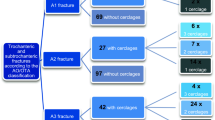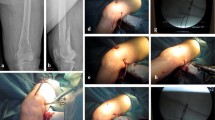Abstract
Purpose
To assess the potential impact of using cerclage cables or wires when undertaking fixation of unstable intertrochanteric and subtrochanteric fractures.
Methods
Patients were identified from a validated hospital database which included patients from all trauma units within Northern Ireland from 2008 to 2015. The primary outcome measure was return to theatre for any reason. Secondary outcome measures included quality of reduction, tip–apex distance, length of stay, mortality at 3 and 12 months and functional outcomes assessed by Barthel Index and mobility.
Results
465 patients were included (157 in the cerclage/wire group and 308 without). Mean age of 79.6 years, with 330 females and 135 males. There was no statistical difference between the groups in relation to baseline demographics and risk factors for complications. 24 patients required further surgery, 13 (8.3%) in the cerclage group and 11 (3.6%) in those without (p < 0.03). Cabling of intertrochanteric fractures resulted in further surgery in 9.1% versus 3.4% without. Quality of reduction was improved in the cerclage group (p < 0.01), however improvements were less noticeable in intertrochanteric fractures (32.3% classified as good) compared to subtrochanteric fractures (52.4% good). Length of stay was longer in the cerclage group (p < 0.01). No differences were noted in mortality, Barthel score or mobility at 3 and 12 months.
Conclusions
Cerclage cables/wires can augment fixation in subtrochanteric fractures with potential benefits including improving quality of reduction. Evidence for their use in intertrochanteric fractures is much more contentious and we would advise they only be used where a definite improvement in reduction can be obtained with the minimum number possible.

Similar content being viewed by others
References
Karayiannis P, McAlinden MG (2016) Falling age-related incidence of hip fractures in women, but not men, in Northern Ireland: 2001 and 2011. Osteoporos Int. https://doi.org/10.1007/s00198-016-3677-5.
International Osteoporosis Foundation: Hip fractures. https://www.iofbonehealth.org/facts-statistics#category16. Accessed Mar 2017.
Centers for disease control and prevention: Hip Fractures amongst older adults.
Parker MJ, Pryor GA, Anand JK, Lodwick R, Myles JW. A comparison of presenting characteristics of patients with intracapsular and extracapsular proximal femoral fractures. J R Soc Med. 85. http://www.ncbi.nlm.nih.gov/pmc/articles/PMC1294817/. Accessed Mar 1992.
Hip Fracture: Evidence Update March 2013. A summary of selected new evidence relevant to NICE clinical guideline 124. The Management of Hip Fractures in Adults 2011.
Riehl JT, Koval KJ, Langford JR, Munro MW, Kupiszewski SJ, Haidukewych GJ. Intramedullary nailing of subtrochanteric fractures: does malreduction matter? Bull Hosp Jt Dis. 2014;72(2):159–63.
Shukla S, Johnston P, Ahmad MA, Wynn-Jones H, Patel AD, Walton NP. Outcome of traumatic subtrochanteric femoral fractures fixed using cephalo-medullary nails. Inj Int J Care Inj. 2007;38:1286–93.
Angelini A, Battiato C. Past and present use of cerclage wires in orthopaedics. Eur J Orthop Surg Traumatol. 2015;25:623–35. https://doi.org/10.1007/s00590-014-1520-2.
Wahnert D, Lenz M, Schlegel U, Perren S, Windolf M. Cerclage handling for improved fracture treatment. A biomechanical study on the twisting procedure. Acta Chir Orthop Traumatol Čech. 2011;78(3):208.
Charnley J. The closed treatment of common fractures. 3rd ed. London: E. and S. Livingstone Ltd; 1961.
Apivatthakakul T, Phaliphot J, Leuvitoonvechkit S. Percutaneous cerclage wiring, does it disrupt femoral blood supply. A cadaveric injection study. Inj Int J Care Inj. 2013;44:168–74.
Perren S, Fernandez A, Regazzoni P. Fracture fixation using cerclage cables. ICUC One Page Paper. September 2015.
National Hip Fracture Database (NHFD) annual report 2016. http://web1.crownaudit.org/Report2016/NHFD2016Report.pdf. Accessed 21 Feb 2017.
Collin C, Wade DT, Davies S, Horne V. The Barthel ADL Index: a reliability study. Int Disabil Stud. 1988;10(2):61–63.
Baumgartner M, Curtin SL, Linskog D, Keggi JM. The value of the tip-apex distance in predicting failure of fixation of peritrochanteric fractures of the hip. JBJS. 1995;77(7):1058–64.
Berton C, Puskas GJ, Christofilopoulos P, et al. Comparison of the outcome following the fixation of osteotomies or fractures associated with total hip replacement using cables or wires: the results at five years. J Bone Jt Surg Br. 2012;94-B:1475–81. https://doi.org/10.1302/0301-620X.94B11.29687.
Craig D, Silverton DO, Joshua J, Jacobs MD, Aaron G. Rosenberg, et al. Complications of a cable grip system. J Arthroplasty. 1996;11(4):400–4.
Hoskins W, Bingham R, Joseph S, Liew D, Love D, Bucknill A, et al. Subtrochanteric fracture: the effect of cerclage wire on fracture reduction and outcome. Inj Int J Care Inj. 2015;46:1992–5.
Kennedy MT, Mitra A, Hietlihy TG, Harty JA, Reidy D, Dolan M. Subtrochanteric hip fractures treated with cerclage cables and long cephalomedullary nails: a review of 17 consecutive cases over 2 years. Inj Int J Care Inj. 2011;42:1317–21.
Afsari A, Liporace F, Lindvall E, Infante A Jr Sagi HC, Haidukewych GJ. Clamp-assisted reduction of high subtrochanteric fractures of the femur. J Bone Jt Surg Am. 2009;91:1913–8.
Muller T, Tropp T, Kuhne CA, Gebhart G, Ruchholtz S, Zettle R. The benefit of wire cerclage stabilisation of the medial hinge in intramedullary nailing for the treatment of subtrochanteric femoral fractures: a biomechanical study. Int Orthop. 2011;35:1237–43. https://doi.org/10.1007/s00264-010-1204-4.
Apivatthakakul T, Phornphutkul C. Percutaneous cerclage wiring for the reduction of periprosthetic and difficult femoral fractures. A technical note. Inj Int J Care Inj. 2012;43:966–71.
Ban I, Birkelund L, Palm H, et al. Circumferential wires as a supplement to intramedullary nailing in unstable trochanteric hip fractures. Acta Orthop. 2012;83(3):240–243. https://doi.org/10.3109/17453674.2012.665329.
Khwaja H, Syed H, Cranston DW. Coding errors: a comparative analysis of hospital and prospectively collected departmental data. BJU Int. 2002;89:178–180.
Author information
Authors and Affiliations
Corresponding author
Ethics declarations
Conflict of interest
Paul Karayiannis and Andrew James declare they have no conflict of interest.
Rights and permissions
About this article
Cite this article
Karayiannis, P., James, A. The impact of cerclage cabling on unstable intertrochanteric and subtrochanteric femoral fractures: a retrospective review of 465 patients. Eur J Trauma Emerg Surg 46, 969–975 (2020). https://doi.org/10.1007/s00068-018-01071-4
Received:
Accepted:
Published:
Issue Date:
DOI: https://doi.org/10.1007/s00068-018-01071-4




